Fischer's Lovebird
Common Names: Fischer's Lovebird, Fischer Lovebird
Scientific Name:
Agapornis fischeri
Origin: Central Africa
Relative Size: 6 inches
Weight: Small
48-53 grams
Average Lifespan:
10 – 20 years.
Egg Clutch: 3-5 white eggs
Incubation: 21 days
Talking Ability:
Poor
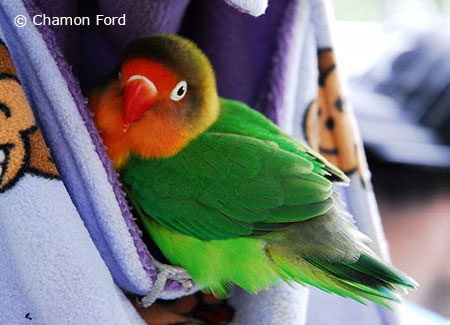
General Information about Fischer's Lovebirds
Of all the lovebird species, the Fischer's Lovebird is the most striking
if not one of the most beautiful parrots available on the market. They
have bright green plumage around the breast area and a yellow bib around
the neck. The bib’s base color is yellow and gradually blends with
bright hues of orange, red, and brown. The lovebird has a white ring
around its eye and a fiery red colored break. The wings and tail are
covered with dark green feathers. These birds resemble rainbows and can
easily compete with Rainbow Lorikeets which are just as colorful. Most
people who see a Fischer's Lovebird will quickly understand why they are
popular as pets.
It is difficult to differentiate between the males and females as they
look almost identical. Some experienced breeders are able to visually
sex the parrots through their skull shape, size, and behavior; however,
the most reliable way to determine the sex of the bird is through
fertile eggs or DNA sexing.
DNA sexing is 99.9% accurate and very affordable. It can cost anywhere
from $15 – $25 dollars per test, depending on which lab you go through.
The procedure is as simple as sending two to four feathers to the lab
(depending on the species or the size of your bird). Results can be
expected within two business days and can be received by email, fax, or
phone. A certificate detailing the sex of the bird is usually provided
by the lab. These labs can be found online though a local breeder or
your local pet store.
These tiny parrots look identical to their cousins the Nyasa Lovebird.
Many inexperienced onlookers find it difficult to tell the difference
between the two species; however, it becomes obvious once the
distinction is pointed out. A Fischer's Lovebird has a blue romp while a
Nyasa Lovebird does not.
These parrots belong to the eye ring group which is made up of four
different species; the Masked Lovebird, the Fischer's Lovebird, the
Black-cheeked Lovebird, and the Nyasa Lovebird.
Mutations/Colors
Fischer's Lovebirds come in a variety of mutations. The most popular mutation is the Lutino. Lutino’s have a bright yellow body and an orange head. The next most popular mutation is the Blue Fischer's Lovebird. They resemble a Blue Masked Lovebird with a lighter black mask. There are so many color combinations that most owners will find a lovebird to their liking. Most prefer the original color as sometimes the mutations can be difficult to come by. Whatever mutation is selected, it will make no difference in the quality of the bird.
Fischer's Lovebirds in the Wild
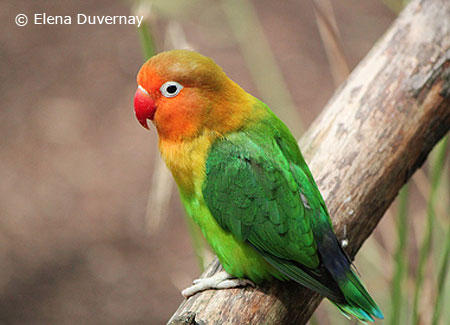
These parrots inhabit a small area in Tanzania, which is south of Lake
Victoria. In Tanzania, these lovebirds can be seen in smaller flocks
foraging for seeds and millet. Though noisy and loud when in flocks,
these parrots are a spectacle to look at simply because they are so
colorful.
During the breeding season, the pair will break from the flock and seek
a cavity to raise their young. Unlike most parrots, Fischer's Lovebirds
will collect nesting material to pad the nest. This unique behavior is
only seen in few parrots; some lovebird species and also the Monk
Parakeet. The male will feed the female and stand guard alerting the
female if danger is near.
If babies are successful at fledging, most will leave the nest by six
weeks, sometimes a few days sooner if well fed and food is abundant.
Fischer's Lovebirds in Captivity
These parrots have been kept in captivity for almost 80 years. The first few pairs took to breeding immediately without much coaxing by handlers. As the populations increased, and birds shipped through Europe, more and more Fischer's Lovebirds were sold and kept. These hardy little parrots eventually became popular as almost any novice breeder could breed them. Soon after, many people discovered their pet qualities which made them even more popular.
Purchasing & Cost of a pet Fischer's Lovebird
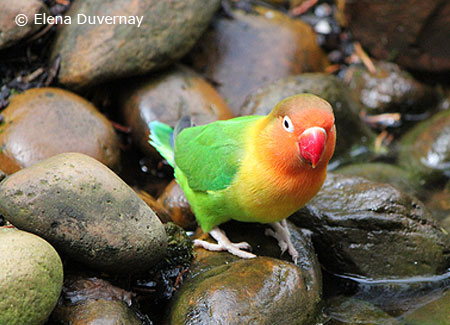
Buying a handfed Fischer’s Lovebird is ideal if you want a tame and
loving pet. They range anywhere from $45.00 – $130. Price really depends
on where the birds are purchased. Lovebirds bred in an aviary are
cheaper but not recommended if the owner wishes to handle the bird.
Buying a handfed bird can be a little more expensive; however, the
payoff can be great. A handfed bird allows the owner to handle it with
more ease and make for better socialized pets as they are used to being
around humans. These birds breed readily so finding a local breeder
should not be difficult. If a local breeder cannot be found, pet stores
also sell Fischer’s Lovebirds. Buying a handfed bird from a franchise
pet store can be a little difficult. However, if you buy a bird that is
not handfed, just know that it will require some time and effort to tame
and to get the lovebird to bond.
When purchasing a Fischer’s Lovebird try and find a reputable breeder.
You can find a good breeder by word of mouth or by asking people that
are in the industry. It’s important to ensure your lovebird is properly
socialized before you buy him. A properly socialized parrot will not be
timid and will gladly enjoy interaction with you. This does not mean
that they will not be a little shy as they need to get use to their new
owners, but it does mean that they will be easier to tame. Along with
being socialized well, the breeder should have already weaned the baby
bird. It’s important the baby eats a variety of foods to ensure optimal
health. If your lovebird does not eat moist foods such as leafy greens,
vegetables, or fruits; start to gradually introduce them into his diet.
Most Fischer's Lovebirds will not eat new foods, but placing a dish
inside the cage daily will encourage them to try it. The key here is
persistence and patience.
Owning a Pet Fischer's Lovebird
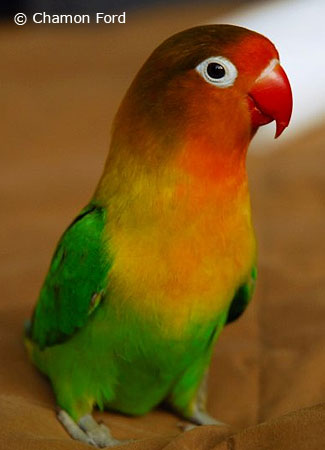
Both male and female Fischer's Lovebirds make wonderful pets. Females
can become a bit nippy during the breeding season and more territorial.
To avoid this type of behavior, move the cage around to new locations
and rearrange perches and toys inside the cage. If the lovebird is kept
as a pet, it is advised not to have a nesting box inside the cage as
this can cause problems.
These tiny birds have large parrot personalities and will delight in
amusing their owners at any cost. These parrots are very curious by
nature and can easily get into trouble if not watched. The owner should
make a great deal of effort to teach the bird simple guidelines to
ensure its safety.
These parrots enjoy spending hours on their owner’s shoulders while a
person does household chores. They are very affectionate parrots and
love to be petted on their neck, back, and wings. They thrive for human
affection and must be held daily to satisfy their need for
companionship.
Tricks
Fischer's Lovebirds can do many tricks. Though they cannot manipulate objects with one hand, they can still wave, turn around, and place objects into boxes. The amount of tricks that your parrot can perform is unlimited; it just takes persistence and patience by the owner. The owner should be creative as these birds can learn many things and will gladly perform tricks for praise or treats.
Talking
Fischer's Lovebirds are not great at talking. They have been known to talk but most do not. The voice of a lovebird is described as raspy and unclear; nonetheless, there is a very small chance a pet lovebird will talk.
Precautions
Since these birds are curious, extra precaution should be taken when your lovebird is out of his cage. They are small and can easily be stepped on. They can also get into everyday household substances that can make them very ill or cause death. These birds need to be taught to play on their stands and not be encouraged to wander off. How can this be done? Every time your lovebird decides to hop off his stand, gently place him back. It only takes a few times before he understands his boundaries. It is important to be one step ahead of your lovebird; they are very inquisitive and can easily get into trouble.
Breeding Fischer's Lovebirds
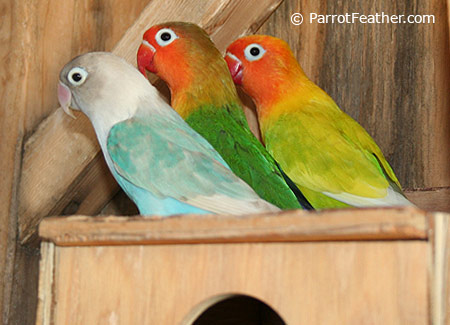
Fischer's lovebirds are easy to breed compared to most parrots. These
birds will breed readily if the right equipment is put inside the cage.
Usually, all that is needed is a large breeding cage, a nesting box,
some nesting material, and an abundant amount of food. Placing nesting
material into the cage will most likely trigger the female into a
breeding mode.
When the pair has been selected and placed into a breeding cage they
will mate continually until the first eggs are laid. The female will
carry nesting material inside her beak into her nesting box to build a
nest. It is important not to place too much nesting material inside the
cage as the female will over do the nest. This might result in eggs
rolling out of the nest or eggs getting buried during incubation.
The right nesting material is essential as lovebirds need moister to
successfully hatch their eggs. Palm leaves should be used as this will
provide a great deal of moister for the developing embryos and aid the
chicks when hatching is near. Fresh long stems of grass can be used as
well, although anything cut from a garden should be cleaned to ensure no
pesticides or bacteria is present. It is also a good idea to research
the plant to ensure it is not toxic to the parrot. In addition, most
female lovebirds will bath daily and this helps to add moister to her
clutch.
Fischer's Lovebirds will breed year round if given the chance, and the
female will produce three to five eggs every other day. The eggs hatch
around 21 days after incubation. Breeders will usually keep the babies
with their mother for 10 to 14 days before all the babies are removed
for hand feeding. Weaning can take as long as six weeks, especially if
the baby is kept alone.
Selecting the right cage for your lovebird
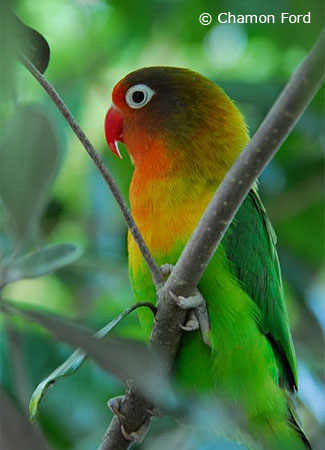
Lovebirds are very active birds and need a cage designed for a
cockatiel. The gap between the bars should be no greater then ½ inch to
ensure the parrot cannot stick his head through the bars. These birds
enjoy hanging from their toys and climbing around their cage. For this
reason, the cage should be large enough to suspend a few toys, perches,
and food and water bowls. It is important the bowls never be placed
under any perches or toys because the lovebird’s food and water can
easily become contaminated with droppings.
The cage should have at least three doors or one large door for easy
access to the bird, toys, and the food and water bowls. It is important
the doors lock because lovebirds are known to be brilliant escape
artists. Most birds can quickly figure out how to escape from their
cages in just a matter of weeks. Make sure that locks are solid.
A tray should be installed on the bottom of the cage with a grill to
ensure the parrot does not have access to spoiled food or his droppings.
Feeding your Fischer's lovebird
Feeding a pet lovebird a healthy diet is important. Lovebirds tend to
be very finicky about eating foods that are unfamiliar. For this reason,
breeders should expose baby lovebirds to all kinds of foods at an early
age so they learn to enjoy a variety of foods. If the pet lovebird
refuses to try new foods, the owner should continue to add new foods
daily as the lovebirds will eventually start to eat it.
These birds should be fed a base diet of seeds or pellets. Most lovebird
mixes in a commercial pet store will work, but it’s important the
lovebirds learn to eat pellets as well because they contain a great deal
of nutrients not found in seeds. It can take time for the lovebird to
eat pellets and the owner should be patient and consistent when exposing
them to pellet food. Not only are seeds and pellets essential, so are
fresh fruits and vegetables.
Lovebirds need to have their food shredded or cubed into small chunks
because they cannot manipulate food as well as larger birds. Items such
as carrots, spinach, broccoli, or apples need to be rotated throughout
the week.
If the lovebird is fed a nutritious diet and taken to the veterinarian
regularly, the owners can expect the bird to live around 10 to 20 years.




